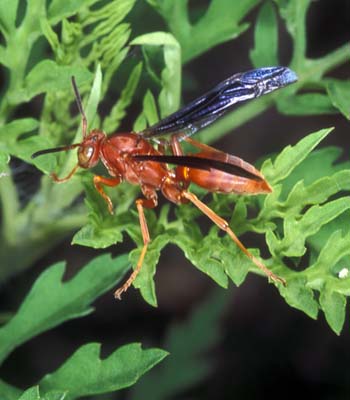
Adult paper wasp, Polistes sp.
(Photographer: Lyle Buss, University of Florida)
Paper wasps have long, slender bodies that are usually reddish-brown in color, and marked with white or yellow rings. These wasps range from 1.7 cm to 3.5 cm in length. Paper wasp nests consist of a single, somewhat circular horizontal comb of paper cells, suspended by a narrow stalk-like structure. The cells of the nest are left open during larval development, but are sealed once pupation begins.
During the spring, fertilized queens find a nesting site and build the nest with the aid of the worker wasps. She then lays individual eggs in each cell. These eggs hatch into legless, grub-like larvae that go through many instars before they pupate.
Paper wasps occur throughout the United States in various natural habitats and on human structures (fences, porches, window frames, attic rafters, eaves, etc.).
Adult paper wasps are voracious predators, feeding on many species of caterpillars, including corn earworms, armyworms and tobacco hornworms. They also prey on other hornets and many types of flies and other arthropods.
Images
To save the Web-optimized images shown below to your hard drive:
|
Click to access Display and Print quality images. |
|
Click to access Display and Print quality images. |
|
Click to access Display and Print quality images. |